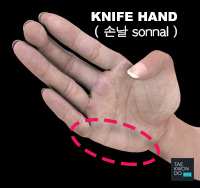Taekwondo 태권도Taekwondo Preschool
Promotion from one geup to the next can proceed rapidly in some schools, since schools often allow geup promotions every two, three, or four months. Students of geup rank learn the most basic techniques first, and then move on to more advanced techniques as they approach first dan. Many of the older and more traditional schools often take longer to allow students to test for higher ranks than newer, more contemporary schools, as they may not have the required testing intervals. View Taekwondo belt levels »

Oh Do Kwan 오도관
The original Taekwondo Kwans. In Korean literally means building or hall, but when used in martial arts it can also refer to a school or clan of martial artists who follow the same style and/or leader.
Oh Do Kwan founded in 1955, was the 6th Kwan to open in Korea. The word Oh (吾) can be translated both as 'mine' and 'our', which makes the meaning of Oh Do Kwan 'the school of my (or our) way'.
General Choi Hong Hi founded the Oh Do Kwan along with Nam Tae Hi in 1953 as part of the Republic of Korea Army's Physical Training Program. The civilian Oh Do Kwan annex was called Dae Han Taekwon-Do Oh Do Kwan Jung Ang Bon Kwan in Seoul. Oh Do Kwan was used to train the South Korean army and the Korean Police throughout South Korea, and in the teaching of taekwondo throughout some universities of Korea. The first people to instruct the army in "Tang Soo Do" (one of the names taekwondo was called in the early 1950s, before the new name taekwondo was submitted on April 11, 1955) were Nam Tae Hi, Woo Jong Lim, Ko Jae Chun, Kim Suk Kyu, Baek Joon Ki, Kwak Keun Sik, Kim Bong Sik, Han Cha Kyo Chung Jang Keun, and Kim Bok Man, almost all of whom were originally Chung Do Kwan members.
Originally Oh Do Kwan was made up of mostly Chung Do Kwan members brought in by senior Chung Do Kwan members Nam Tae Hi and Han Cha Kyo. Choi Hong Hi was the political power in the kwan, and also taught Nam Tae Hi, who was the head instructor, his new system. Yet, because of their work to develop Oh Do Kwan under the leadership and command of General Choi, they were almost all expelled from Chung Do Kwan.
The first documented patterns to be unique to taekwondo are the Chang Hun tul and were designed by General Choi, with assistance from Nam Tae Hi and Han Cha Kyo and originally practiced at the Oh Do Kwan. These patterns were spread throughout the world by General Choi upon his creation of the International Taekwondo Federation (ITF) in 1966. The Chang Hun patterns began to be adopted by civilian Do Jang, too.
Today the Oh Do Kwan still exist in Korea for over three decades as a social friendship club and has an annual celebration every year in Seoul. Oh Do Kwan was dissolved as a martial art system in the mid-1970s. Oh Do Kwan along with the eight other Kwan's moved to form the Kukkiwon in 1972. As all the other Kwans have issued Dan certificates and instructor certificates, so has Oh Do Kwan. However, these certification only serve as membership in the fraternity. Oh Do Kwan endorses and follows the Kukkiwon curriculum. Oh Do Kwan's current president is Han Myung Hak.

Highlight Knife Hand ( 손날 sonnal ) Posture
By tucking the thumb into the palm, a surface called the knife hand or hand blade ( 손날 sonnal ) is formed. The surface extends with the muscle at the side of the hand located between the base of the small finger and the wrist ( 팔목 palmok ). The hand blade is used as both an offensive and defensive technique which can be executed as a high, low, middle, side, inward, outward, rising or circular. Use of this technique as both a strike and block is featured prominently in many of the World Taekwondo (WT) Taegeuk Poomse.
* Please see a certified Master Instructor ( 사범님 sabeomnim ) for training. Proper guidance and instructions are needed to ensure safe training.

Original Taekwondo Kwans ( 관 )
In Korean, kwan ( 관 ) literally means building or hall, but when used in martial arts it can also refer to a school or clan of martial artists who follow the same style and/or leader. On January 8, 1977, nine of the largest kwans unified, recognizing the Kukkiwon 국기원 as being the black belt promotional body for taekwondo. Prior to this declaration, many practitioners had considered their individual kwan certifications as being more valuable than the certificates which were issued by the Kukkiwon 국기원 or Korea Taekwondo Association (KTA). For more information View Taekwondo Kwans ( 관 ) »
There are five tenets defined in the International Taekwondo Federation (ITF) and several more in World Taekwondo (WT).
Indomitable Spirit ( 백절불굴 baekjul-boolgool ): "To have indomitable spirit means to have the courage to stand up for what you believe in, no matter what odds you are up against, and to always give 100% effort in whatever you do." View Taekwondo Tenets »
RESOURCES
This article uses material from the Wikipedia article "Oh Do Kwan", which is released under the Creative Commons Attribution-Share-Alike License 3.0.


















